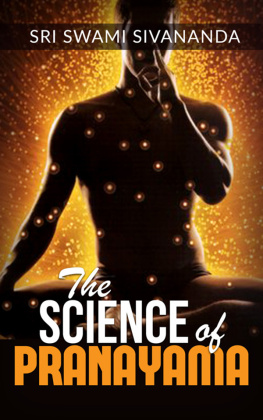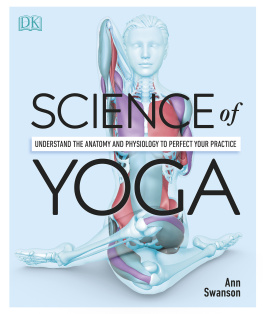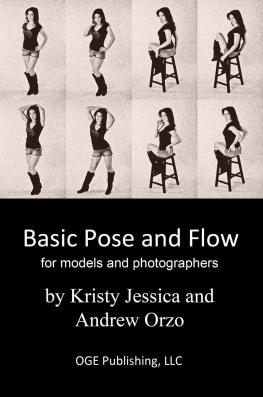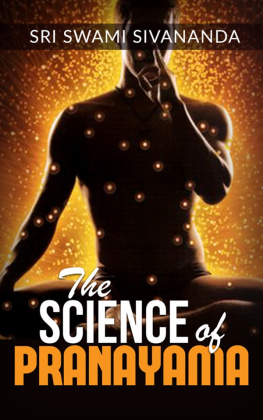Sivananda - The Science of Pranayama
Here you can read online Sivananda - The Science of Pranayama full text of the book (entire story) in english for free. Download pdf and epub, get meaning, cover and reviews about this ebook. publisher: Youcanprint, genre: Religion. Description of the work, (preface) as well as reviews are available. Best literature library LitArk.com created for fans of good reading and offers a wide selection of genres:
Romance novel
Science fiction
Adventure
Detective
Science
History
Home and family
Prose
Art
Politics
Computer
Non-fiction
Religion
Business
Children
Humor
Choose a favorite category and find really read worthwhile books. Enjoy immersion in the world of imagination, feel the emotions of the characters or learn something new for yourself, make an fascinating discovery.
The Science of Pranayama: summary, description and annotation
We offer to read an annotation, description, summary or preface (depends on what the author of the book "The Science of Pranayama" wrote himself). If you haven't found the necessary information about the book — write in the comments, we will try to find it.
PUBLISHERS NOTE
INTRODUCTION
CHAPTER ONE
Prana and Pranayama
Sub-Pranas and Their Functions
The Colour of Pranas
The Length of the Air-Currents
The Centering of the Prana
The Lungs
Sushumna
Kundalini
Shat-Chakras
Nadis
Purification of Nadis
Shat-Karmas (The Six Purificatory Processes)
Dhauti
Basti
Neti
Nauli
Kapalabhati
CHAPTER TWO
The Meditation Room
The Five Essentials
The Place
The Time
The Adhikari
Dietetic Discipline
Yogic Diet
Mitahara
Purity in Food
Charu
Milk Diet
Fruit Diet
Articles Allowed
Articles Forbidden
A Kutir For Sadhana
Matra
Padmasana (Lotus Pose)
Technique
Siddhasana (The Perfect Pose)
Technique
Svastikasana (Prosperous Pose)
Samasana (Equal Pose)
Three Bandhas
Arambha Avastha
Ghata Avastha
Parichaya Avastha
Nishpatti Avastha
CHAPTER THREE
What...
The Science of Pranayama — read online for free the complete book (whole text) full work
Below is the text of the book, divided by pages. System saving the place of the last page read, allows you to conveniently read the book "The Science of Pranayama" online for free, without having to search again every time where you left off. Put a bookmark, and you can go to the page where you finished reading at any time.
Font size:
Interval:
Bookmark:
THE SCIENCE OF PRANAYAMA
by
SRI SWAMI SIVANANDA
First Edition: 1935
David De Angelis 2017 [all rights reserved]
TABLE OF CONTENTS
It is needless for us to stress on the merits of the subject or its author, Sri Swami Sivanandaji Maharaj. Sri Swamiji already lives in the hearts of the people of the world as an unfailing saviour. The Swamijis method of presenting such intricate Yogic subjects in an inimitable, simple style with convincing assurances in unique and unrivalled. It is authoritative, the more so, because of Swamiji being a combination of an experienced medical practitioner, a full-blown Yogi and a Jivanmukta.
The practice of Pranayama has been viewed with fear in certain quarters on account of certain limitations, viz., the absolute necessity of the nearness to a perfected Guru, the dietetic restrictions and the like. Sri Swamiji has explained herein in clear terms the vagaries of such fears and has prescribed very simple and safe methods. The book contains suitable lessons for all types of Sadhakas. Those who follow the special instructions given towards the end of the book can be sure of their guaranteed success and safety.
Pranayama is an important Anga in Ashtanga Yoga. It is equally necessary for all in their daily life, for good health, success and prosperity in every walk of life. How it is so, is explained in these pages. The science of relaxation is a very valuable gift for the readers and would benefit all.
We are greatly encouraged by the warm reception the previous editions had at the hands of our dear readers and we hope more and more Sadhakas would take up this important aspect of Sadhana in their daily spiritual practices, and feel for themselves the happiness and joy which will naturally lead them to blissful Divine Life.
THE DIVINE LIFE SOCIETY

Today, for quick travel, the material world presents us the Railway, Steamers, Aeroplanes and so forth, but the Yogins claim that by Yogic culture the weight of the body can be so reduced that it can fly over the space to any distance in an instant. They can prepare a magic ointment, which when applied to the soles of the feet, gives them power to traverse any distance on earth within a very short time. By the practice of Khechari Mudra, by applying the elongated tongue to the posterior nasal openings they can fly in the air. By keeping a magic pill in their mouth they can also move in space to any place in the twinkling of an eye. When we are anxious to know the welfare of our own relations in a distant or foreign land, we take recourse to writing letters sending ordinary or urgent cables. But the Yogins claim that they can, by meditation (Dyana), know anything that happens in other parts of the world by a projection of the mind or by mentally travelling the distance which is only a matter of few seconds. Yogi Lahiri, whose Samadhi is still in Varanasi, travelled to London to see the state of health of his superiors wife. For hearing a friend at a long distance the material world presents us with telephones and wireless receivers, but the Yogins claim that through their Yogic power, they can hear anything, from any distance, even the voices of God and other invisible beings in the firmament. Today when a man is suffering from a disease the material world presents us with doctors, medicines, injections and so forth, but the Yogins claim that by a mere glance or by simple touch or by recitation of Mantras, not only the diseases can be cured but also life can be given to a dead man.
These Yogins by persistent effort in concentration get different Yogic powers that are known as Siddhis. Those who acquire these Siddhis, are known as Siddhas. The process through which they obtain Siddhis, is called Sadhana. Pranayama is one of the most important Sadhanas. Through the practice of Asana, you can control the physical body and through Pranayama, you can control the subtle, astral body or the Linga Sarira. As there is an intimate connection between the breath and nerve-currents, control of breath leads to the control of vital inner currents.
Pranayama occupies a very important place in Indian religion. Every Brahmachari, and every Grihastha also, has to practise it three times every day morning, noon and evening in his daily worship during Sandhya. It precedes every religious practice of the Hindus. Before he eats, before he drinks, before he resolves to do anything, Pranayama should be performed first and then the nature of his determination should be clearly enunciated and placed before the mind. The facts of its preceding every effort of the will is a surety that, that effort will be crowned with success and the mind will be directed to bring about the desired result. Here I may refer to the feat of memory, practised by the Hindu Yogins, under the name of concentration on one hundred things.
Satavadhana, wherein one hundred questions are put to a Satavadhani or the concentrator in rapid succession by different persons; some testing the verbal memory of the performer; others testing his power of mental calculation; again some others, trying to test his artistic skill, without giving him, any time for committing the questions to have been put to him. The performer begins, by reproducing the questions, in any order, in respect of those questions, with their answers. This is generally done in three or more turns, in each turn giving only a portion of the answer to each of the questions and then continuing from where he left off in the next turn. If the questions are of the nature of mathematical problems whose solutions are required, he delivers the answers along with the problems, having solved them mentally.
This faculty of concentration of mind is often exhibited not only with reference to the intellect but also with reference to the five senses. A number of bells may be marked differently and the sounds may be allowed to be studied and made mental note of with the mark given to it. A number of objects of similar shape and colour which are likely to cause deception to the eye of an ordinary man may be shown once to the Avadhani with their marks. While he is attending to other things, if a bell were to be struck or one of the objects suddenly exhibited before his sight, he will at once mention the mark of the bell or the number of the object shown. Similarly his keenness of touch is also put to the test. Such feats of memory are due to the training which they receive from the daily practice of Pranayama.
The Prana may be defined as the finest vital force in everything which becomes visible on the physical plane as motion and action and on the mental plane as thought. The word Pranayama, therefore, means the restraint of vital energies. It is the control of vital energy which tingles through the nerves of persons. It moves his muscles and causes him to sense the external world and think his internal thought. This energy is of such a nature that it may be called the vis viva of the animal organism. The control of this force is what is aimed at by the Yogins by means of Pranayama. He who conquers this, is not only the conqueror of his own existence on the physical and mental plane, but the conqueror of the whole world. For, the Prana is the very essence of cosmic life, that subtle principle which evolved the whole universe into its present form and which is pushing it towards its ultimate goal. To the Yogi the whole universe is his body. The matter which composes his body is the same that evolved the universe. The force which pulsates through his nerves is not different from the force which vibrates through the universe. The conquest over the body does, therefore, mean to him the conquest over the forces of nature. According to the Hindu Philosophy the whole nature is composed of two principal substances. One of them is called the Akasa or ether and the other, Prana or energy. These two may be said to correspond to matter and force of the modern scientists. Everything in this universe that possesses form or that has material existence, is evolved out of this omnipresent and all-pervasive subtle substance Akasa. Gas, liquid and solid, the whole universe, consisting of our solar system and millions of huge systems like ours and in fact every kind of existence that may be brought under the word created, are the products of this one subtle and invisible Akasa and at the end of each cycle return to the starting point. In the same way, all the way of forces of nature that are known to man; gravitation, light, heat, electricity, magnetism all those that can be grouped under the generic name of energy, physical creation, nerve-currents, all such as are known as animal forces and thought and other intellectual forces also, may be said to be the manifestations of the cosmic Prana. From Prana, they spring into existence and in Prana, they finally subside. Every kind of force in this universe, physical or mental can be resolved into this original force. There can be nothing new except these two factors in some one of their forms. Conservation of matter and conservation of energy are the two fundamental laws of nature. While one teaches that the sum total of Akasa forming the universe, is constant, the other teaches that the sum total of energy that vibrates the universe, is also a constant quantity. At the end of each cycle the different manifestations of energy quiet down and become potential: so also the Akasa which becomes indistinguishable: but at the beginning of the next cycle the energies start up again and act on the Akasa so as to involve the various forms. Accordingly, when the Akasa changes and becomes gross or subtle, Prana also changes and becomes gross or subtle. As the human body is only a microcosm to a Yogi, his body composed of the nervous system and the internal organs of perception represent to him, the microcosmic Akasa, the nerve-currents and thought-currents, and the cosmic Prana. To understand the secrets of their workings and to control them is, therefore, to get the highest knowledge and the conquest of the universe.
Next pageFont size:
Interval:
Bookmark:
Similar books «The Science of Pranayama»
Look at similar books to The Science of Pranayama. We have selected literature similar in name and meaning in the hope of providing readers with more options to find new, interesting, not yet read works.
Discussion, reviews of the book The Science of Pranayama and just readers' own opinions. Leave your comments, write what you think about the work, its meaning or the main characters. Specify what exactly you liked and what you didn't like, and why you think so.






